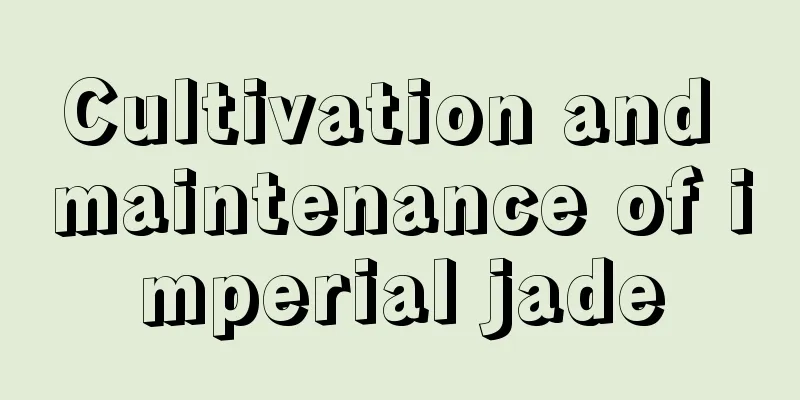Jasmine planting methods and techniques

|
Jasmine is loved for its evergreen leaves and elegant white flowers. It exudes a rich fragrance and usually blooms in spring and summer, bringing vitality to the home. The following are the methods and techniques for growing jasmine. 1. Watering Jasmine likes a humid environment, and the watering methods vary in different seasons: Water once every afternoon in spring. Water once in the morning and evening in summer. Water 2-3 times a week in autumn. Water once a week in winter. Regardless of the season, watering should be done according to the dryness and wetness of the potting soil to ensure that each watering is thorough and avoid water accumulation. In rainy seasons, it is necessary to avoid rain in time to prevent the soil in the pot from being too wet and causing root rot. When using tap water, it is recommended to leave it for 3-5 days before use to avoid soil alkalinization. 2. Fertilization When planting or repotting, apply an appropriate amount of well-rotted farmyard manure as base fertilizer at the bottom of the pot to avoid direct contact with the roots, and cover the soil well. Apply nitrogen fertilizer in spring, dilute it and water it on the soil surface to promote the sprouting of new branches and leaves. Apply phosphorus and potassium fertilizers before flowering in summer, and spray potassium dihydrogen phosphate foliar fertilizer to promote flowering and prolong the flowering period. After the flowering period, apply compound fertilizer once every half a month, and apply it 3-4 times in a row to replenish the nutrients consumed by flowering. Stop fertilizing after winter. 3. Lighting Management Jasmine needs plenty of sunlight to keep the plant strong and the flower buds forming. Summer is the peak flowering period. It needs to be avoided from direct sunlight, placed in a well-lit place and kept ventilated. 4. Pruning method Pruning is usually done in early spring or autumn, and when repotting, branches that are too dense, too long, withered, or diseased and insect-infested should be pruned, and old leaves should be removed appropriately to promote the sprouting of new branches. Cut off the remaining flowers in time after flowering to encourage the plant to grow more new flower buds. 5. Notes The minimum maintenance temperature in winter should be kept above 10 degrees. Temperatures below 5 degrees may cause leaf damage or drying. Heavy pruning is not recommended in summer to avoid affecting the growth of the plants. When maintaining indoors, maintain good ventilation to prevent the breeding of diseases and pests. The above is an introduction to jasmine planting techniques. By doing a good job of daily maintenance, you can easily maintain jasmine, allowing it to thrive at home and bloom beautiful flowers.
|
<<: The best way for Brazilian tortoises to spend the winter
>>: How does Milan flower survive the winter?
Recommend
Is it good to soak egg skins in water and water flowers? The benefits and methods of soaking eggs in water and watering flowers
It is okay to use egg shells to soak in water and...
How to grow lilies in small pots
1. Lighting The lilies in small pots have just be...
When is the best time to plant plums?
Best time to plant plums Plums can be planted fro...
How to plant Kochia seeds
1. Collect seeds It is an annual herb and seeds n...
Why is the Kalanchoe so lush but not blooming?
1. Leggy Cause: There are many possible reasons w...
The advantages and disadvantages of Marshmallow Bubble Rose
The color of the Marshmallow Bubble Rose is a ver...
Difference between Albizia Julibrissin and Mimosa
1. Differences in plants The Albizia Julibrissin ...
Is Sea Tiger Orchid poisonous?
1. Is it poisonous? Sea tiger orchid is not poiso...
Cultivation method of cinnabar root potted plants
Cinnabar root is an evergreen shrub of the genus ...
Can tomato seeds be planted?
Can tomato seeds be planted? Tomato seeds can be ...
How to grow Dendrobium at home and how to survive the winter in the north
1. Planting method 1. Prepare the substrate: When...
Cultivation methods and precautions for hydroponic tulips
Hydroponic tulips are easy to grow. Compared with...
How to propagate Kapok
Grafting Rootstock cultivation Kapok seeds mature...
Can lucky bamboo be grown in soil after it has grown roots?
1. Can be grown in soil Although most lucky bambo...
Symptoms and treatment methods of flower injuries
Symptoms of water shortage in flowers When many f...









